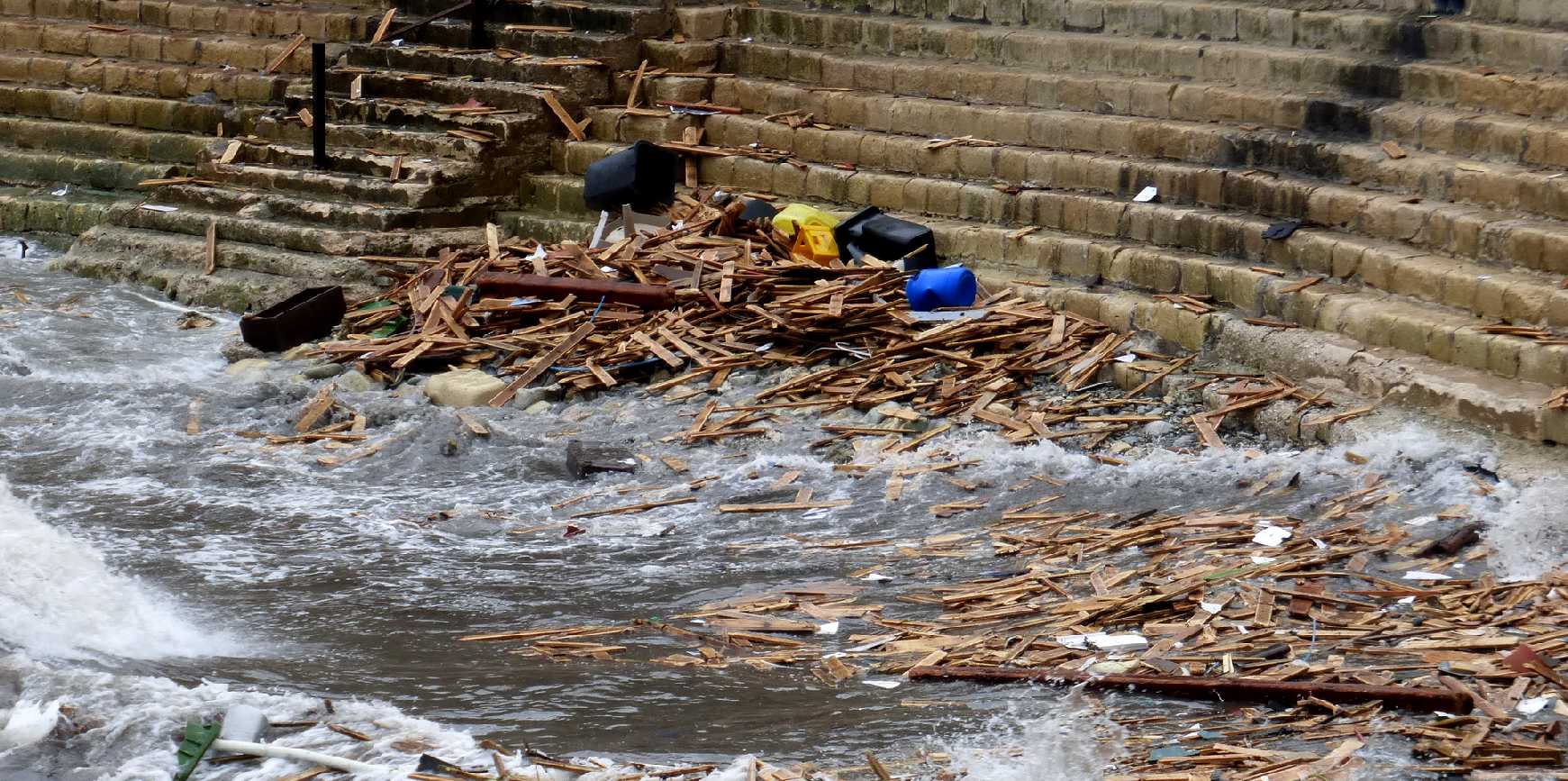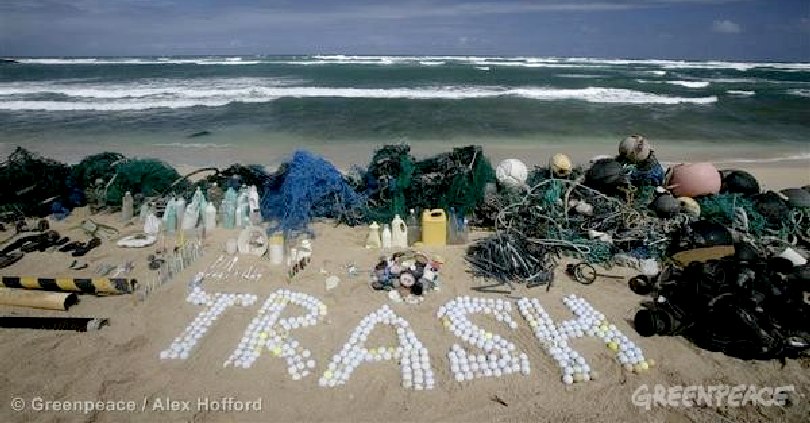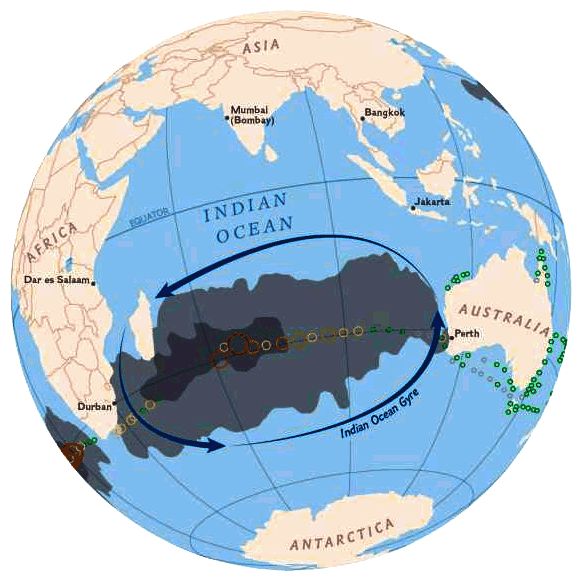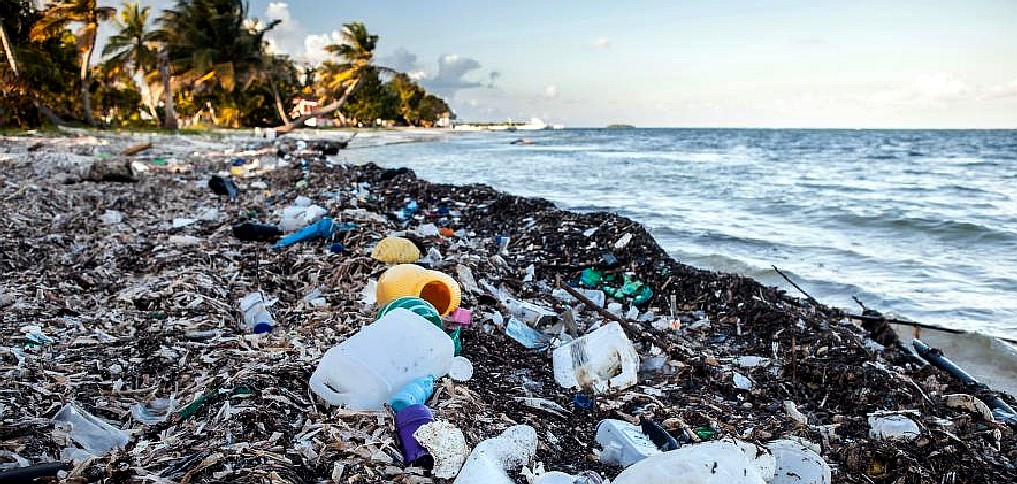|
OCEAN
WASTE
ABOUT -
CONTACTS - FOUNDATION -
HOME - A-Z INDEX

THE
INDEPENDENT FEB 2015 - The world’s oceans are being filled with enough plastic waste to thickly line every coastline in the world, according to the first detailed global assessment of the problem.
Scientists estimate that about 8 million tons of plastic debris such as food packaging and plastic bottles are being washed into the oceans each year – and the cumulative quantity of waste will result in a tenfold increase in the total amount of plastic in the sea by 2020.
“Our estimate of 8 million metric tons going into the oceans in 2010 is the equivalent to five grocery bags filled with plastic for every foot of coastline in the world,” said Jenna Jambeck, assistant professor of environmental engineering at the University of Georgia.
“In 2025, the annual input would be about twice the 2010 input, or 10 bags full of plastic per foot of coastline. So the cumulative input for 2025 would be nearly 20 times our 2010 estimate – 100 bags of plastic per foot of coastline in the world.”
Researchers had previously calculated that there were about 245,000 tons of plastic waste in the oceans. But this was based on the amount of plastic found floating on the sea surface and did not take into account the waste that has sunk.
Marine debris, also known as marine litter, is human-created waste that has
been either deliberately or accidentally released in a lake, sea, ocean or waterway. Floating oceanic debris tends to accumulate at the center of gyres and on coastlines, frequently washing aground, when it is known as beach litter. Deliberate disposal of wastes at sea is called ocean dumping. Naturally occurring debris, such as driftwood, are also present.
With the increasing use of
plastic, human influence has become an issue as many types of plastics do not biodegrade. Waterborne plastic poses a serious threat to fish, seabirds, marine reptiles, and marine mammals, as well as to boats and coasts. Dumping, container spillages, litter washed into storm drains and waterways and wind-blown landfill waste all contribute to this problem.
THE LAW
Ocean dumping is supposedly controlled by international law, including:
* The London Convention (1972) – a United Nations agreement to control ocean dumping
* MARPOL 73/78 – a convention designed to minimize pollution of the seas, including dumping, oil and exhaust pollution
European law
In 1972 and 1974, conventions were held in Oslo and
Paris respectively, and resulted in the passing of the OSPAR Convention, an international treaty controlling marine pollution in the north-east
Atlantic
Ocean. The Barcelona Convention protects the Mediterranean
Sea. The Water Framework Directive of 2000 is a European Union directive committing EU member states to free inland and coastal waters from
human influence. In the
United
Kingdom, the Marine and Coastal Access Act 2009 is designed to "ensure clean healthy, safe, productive and biologically diverse oceans and seas, by putting in place better systems for delivering sustainable development of marine and coastal environment".
United States law
In 1972, the United States Congress passed the Ocean Dumping Act, giving the Environmental Protection Agency power to monitor and regulate the dumping of sewage sludge, industrial waste, radioactive waste and biohazardous materials into the nation's territorial waters. The Act was amended sixteen years later to include medical wastes. It is illegal to dispose of any plastic in
US waters.
Admiralty
ownership law
Property law, admiralty law and the law of the sea may be of relevance when lost, mislaid, and abandoned property is found at sea. Salvage law rewards salvors for risking life and property to rescue the property of another from peril. On land the distinction between deliberate and accidental loss led to the concept of a "treasure trove".
In the United Kingdom, shipwrecked goods should be reported to a Receiver of
Wrecks, and if identifiable, they should be returned to their rightful owner.
We doubt that ocean plastic could be described as shipwrecked
goods, unless there is an actual shipwreck to link it to
locally.
As
you may agree, the amount of waste that is in our oceans and
seas is evidence that all the laws on the planet are (so far)
not effective in regulating disposal of waste at sea. Governments
and governmental organizations simply do not care enough about
ocean waste to invest in research aimed at regeneration. The
one exception is Avaaz,
who through their crowd funding network has contributed
significantly to the ongoing research on the SeaVax
ocean cleaning concept.

GREENPEACE
CAMPAIGNS
Take a walk along almost any beach anywhere in the world and washed ashore will almost certainly be either plastic bags and bottles, or containers. Perhaps plastic drums or expanded polystyrene packing. All too often there are polyurethane foam pieces, pieces of polypropylene fishing net and discarded lengths of
rope. Together with traffic cones, disposable lighters, tyres and even toothbrushes, this plastic trash has been casually thrown away on land or at sea and has been carried ashore by
wind and tide.
Plastics can also act as a sort of "chemical sponge", concentrating many of the most damaging of the pollutants found in the world’s oceans: the persistent organic pollutants (POPs). So any animal eating these pieces of plastic debris will also be taking in highly toxic pollutants.
One of the things that makes plastic so heavily used domestically and commercially - its durability - also makes it a major problem for our oceans, and will continue to do so for generations. Around 100 million tonnes of
plastic are produced each year, of which about 10 million tonnes ends
up in the sea according to some estimates. About 80% of it comes from land.
The larger items are the visible signs of a much bigger problem. At sea and on shore under the influence of sunlight, wave action and mechanical abrasion these larger items slowly break up into smaller pieces. Plastic doesn’t break down like natural materials – it doesn’t go away, it just goes from being a floating bottle to tiny plastic particles that are easily eaten by fish and other marine species or simply spread even further afield. A single one-litre bottle could break down into enough small fragments to put one on every mile of beach in the entire world.
Small plastic pellets aren’t just the result of natural erosion. Cargo ships are increasingly carrying packing cases using small plastic pellets as stuffing and these are liberally dispersed across the oceans when drum-loads or even container loads are lost at sea. The pellets are frequently found during beach clean-ups, but also at sea in areas where winds and currents are weak.
A turtle found dead in Hawaii had over a thousand pieces of plastic in its stomach and intestines. It has been estimated that over a million seabirds and one hundred thousand marine mammals and sea turtles are killed each year by either eating or getting tangled in six-pack plastic can holders, and discarded netting, fishing lines and other bits of discarded plastic.

OCEAN
ACTIVISM
A large number of groups and individuals are active in preventing or educating about marine debris. For example, 5 Gyres is an organization aimed at reducing plastics pollution in the oceans, and was one of two organizations that recently researched the Great Pacific Garbage Patch. Heal the Bay is another organization, focusing on protecting California's Santa Monica Bay, by sponsoring beach cleanup programs along with other activities. Marina DeBris is an artist focusing most of her recent work on educating people about beach trash. Interactive sites like Adrift demonstrate where marine plastic is carried, over time, on the worlds ocean currents. On April 11, 2013 in order to create awareness, artist Maria Cristina Finucci founded The Garbage patch state at
UNESCO –
Paris in front of Director General Irina Bokova . First of a series of events under the patronage of UNESCO and of Italian Ministry of the Environment.
Forty-eight plastics manufacturers from 25 countries, are members of the Global Plastic Associations for solutions on Marine Litter, have made the pledge to help prevent marine debris and to encourage recycling.
IMPACT ON HUMANS
There is now serious concern that there is so much plastic pollution in the seas and oceans that it is inevitable that humans will end up ingesting plastic through the fish and seafood we eat. While the larger fish humans eat may not directly eat microplastics they may accumulate microplastics in their bodies when they are immature fry, or through feeding on smaller fish which are full of microplastics. A study in the science journal Nature found that a quarter of fish and shellfish bought at markets in Indonesia and
California contained plastic, while researchers at the University of Ghent in Belgium have calculated that people eating shellfish on a regular basis will consume 6,400 pieces of
microplastic a year. A small proportion of these will accumulate in the human body and there has yet to be any substantive research carried out to understand the long-term effects this will have on human health.
It is not just microplastics which are an issue. Research carried out by the University of Arizona found that chemicals used in the manufacture of plastic
“may migrate into fish flesh and thus edible parts of seafood” and in accumulated concentrations they may be harmful to humans. Some very harmful chemicals are found in
plastics. Persistent Organic Pollutants (POPs) are chemicals found in pesticides, flame retardants and
electrical insulation which are resistant to environmental
degradation. While many of these have been banned since the 1970s they will remain present in sea water for decades.
Once plastic ends up in the ocean these chemicals can be absorbed into
smaller plastic pieces which are then consumed by fish and shellfish. Research by the University of Exeter found that plastic found off the coast of
Japan had chemical levels over one million times higher than that found in the surrounding sea water.
The issue of both plastic and chemical ingestion in fish very much affects the
UK, with the
Daily Mail quoting a report which found that 30% of fish in the
English Channel had some form of plastic in their bodies, and over 80% of scampi sold in the UK also contained plastic.
Ocean plastic pollution is a truly global problem, with microplastics even being found frozen into
arctic ice
and in deep sea ecosystems at depths of 6000ft (1820 metres).

NATIONAL
GEOGRAPHIC - Emily Penn skippers the 72-foot, steel-hulled Sea Dragon, which carries scientists, including Eriksen and Jambeck, on sea trash sampling surveys. She expertly handles the nets trawled behind the vessel and knows what to expect. Nevertheless, she is still surprised and dismayed by the volume of trash.

NATIONAL
GEOGRAPHIC JAN 2015 - 5.25 TRILLION PIECES & COUNTING
The numbers add up to trouble for the oceans, wildlife, and us, but scientists are struggling to understand how.
The numbers are staggering: There are 5.25 trillion pieces of plastic debris in the ocean. Of that mass, 269,000 tons float on the surface, while some four billion plastic microfibers per square kilometer litter the deep sea.
Scientists call these statistics the "wow factor" of ocean trash. The tallies, published last year in three separate scientific papers, are useful in red-flagging the scope of the problem for the public. But beyond the shock value, just how does adding up those rice-size fragments of plastic help solve the problem?
Although scientists have known for decades about the accumulating mass of ocean debris and its deadly consequences for seabirds, fish, and marine animals, the science of sea trash is young and full of as-yet unsolved mysteries. Almost nothing was known about the amount of plastic in remote regions of the Southern Hemisphere, for example, until last year because few had ever traveled there to collect samples. (Related: "With Millions of Tons of Plastic in Oceans, More Scientists Studying Impact.")
"The first piece is to understand where it is," says Kara Lavender Law, an oceanographer at the Sea Education Association in
Woods Hole, Massachusetts.
Indeed, until scientists learn more about where ocean trash is, how densely plastic accumulates in different ocean ecosystems, and how it degrades, they can't really calculate the damage it's causing. There are still big, basic questions: As it degrades, do plastic toxins seep into the marine environment? If so, how and in what amounts?
And though scientists know a great deal about the damage to marine life caused by large pieces of plastic, the potential harm caused by microplastics is less clear. What effect do they have on fish that consume them?
"The greater the concentration, the greater the potential risk for exposure," says Richard Thompson, a biologist at Plymouth University in England, whose study released last month identified microfibers widely disseminated throughout the deep ocean. "If we are missing a major sink where there are major concentrations of plastic, we might not be learning how harmful plastics are." (Related: "First of Its Kind Map Reveals Extent of Ocean Plastic.")
The most recent counts add significantly to the knowledge base, yet even those big numbers are a fraction of the plastic that flows into the oceans every year. Where's the rest of it? It's another mystery. (Related: "Where Has All the (Sea Trash) Plastic Gone?")
We are dealing with pieces from hundreds of meters down to microns in size," Thompson says. "It is incredibly challenging to monitor."
Ocean trash is counted in three ways: through beach surveys, computer models based on samples collected at sea, and estimates of the amount of trash entering the oceans.
The most recent counts involved computer modeling based on samples taken at sea. The models may not account for all of the trash, scientists say; nonetheless, the new numbers are helping address some of the questions.
The process of collecting and counting is meticulous, time-consuming work. It took Marcus Eriksen, co-founder of the 5 Gyres Institute, a nonprofit ocean advocacy group, more than four years, using samples gathered from 24 survey trips, to come up with his estimate that 5.25 trillion pieces of debris float on the surface.
In the course of his expeditions, Eriksen collected everything from plastic candy wrappers to giant balls of fish netting. One massive ball of netting, found midway across the Pacific, contained 89 different kinds of net and line, all wrapped around a tiny, two-inch-high teddy bear wearing a sorcerer's cap at the center.
He says his research has helped fill in the outlines of the life cycle of ocean plastic. It tends to collect in the world's five large gyres, which are large systems of spiraling currents. Then, as the plastic degrades into fragments, it falls into deeper water, where currents carry it to remote parts of the globe.
"These fragments are anywhere on the planet at this point," he says. "We're finding them everywhere."





GLOBAL
WASTE PROBLEM - The
above views of planet earth as global views show us the Atlantic, Indian and
Pacific ocean gyres and estimates of plastic waste in
(thousands) numbers of pieces of plastic waste per square kilometer
of sea. The Pacific
Ocean gyres are held to be the worst at the moment.
BY
THE NUMBERS
Eriksen's findings agree with those of a Spanish scientist, Andres Cozar Cabañas, a researcher at the University of Cadiz, in Spain, who published the first global map of floating ocean debris last July. Their estimates are strikingly similar.
"We now have two estimates of what is floating, and they are almost identical," says Lavender Law. "They used different data sets and different methodology and came up with the same number. That gives us confidence we're in the right ballpark."
Another way of coming up with the numbers is to make crude guesses based on manufacturing statistics. Says Jenna Jambeck, a University of Georgia environmental engineer who is completing a worldwide calculation of garbage collected in coastal countries: "If you have 200 million tons produced every year, researchers will arbitrarily estimate that 10 percent goes into the oceans."

SORT OUT THE RUBBISH
It's not too difficult to surmise why so much plastic ends up in the ocean. The Plastic Disclosure Project, a project run by Hong Kong-based advocacy group Ocean Recovery Alliance, estimates that 33 percent of plastic manufactured worldwide is used once, then discarded. To compound matters, 85 percent of the world's plastic is not recycled.
Despite the magnitude of the numbers, Peter Ryan, a zoologist at the University of Cape Town,
South
Africa, who is writing a book tracing the evolution of marine debris research, says the problem can be solved.
"Marine debris, unlike global warming, should be an easy thing to deal with," he says. "We have to sort out what to do with our rubbish."
Ryan began tracking debris 30 years ago, after a colleague suggested he should study seabirds that were eating floating plastic pellets, then commonly used in manufacturing and found in harbors and other waterways. Improvements to
shipping reduced pellet spillage.
"If you go to the beach today, you struggle to find one," he says. "We can show that in every study that looks at the North Atlantic that the amount of pellets [ingested by] seabirds has decreased over the last two decades."
But gains on that front have given way to losses in others, as microplastics have become more prevalent.
Emily Penn skippers the 72-foot, steel-hulled Sea Dragon, which carries scientists, including Eriksen and Jambeck, on sea trash sampling surveys. She expertly handles the nets trawled behind the vessel and knows what to expect. Nevertheless, she is still surprised and dismayed by the volume of trash.
"The thing that shocks me every time is the fact that the ocean looks like it is clear blue water," she says. "And then ... we pull out that sock at the end of the net and find it's full of thousands of fragments of plastic."
By Laura Parker

TRAPPED -
A sea
turtle is ensnared in this fishing net. Fishing nets are made
of plastic that is very tough and float around killing marine
wildlife and when they finally sink, cause more harm to ocean
ecosystems.
LINKS
& REFERENCE
http://www.whoi.edu/
http://news.nationalgeographic.com/news/2015/01/150109-oceans-plastic-sea-trash-science-marine-debris/
http://www.independent.co.uk/environment/plastic-waste-in-ocean-to-increase-tenfold-by-2020-10042613.html
https://en.wikipedia.org/wiki/Marine_debris
http://britishseafishing.co.uk/microplastics-and-ocean-pollution/
https://sustainabledevelopment.un.org/sdg14
http://wef.ch/plasticseconomy
ABS
- BIOMAGNIFICATION
- BP DEEPWATER - CANCER
- CARRIER BAGS
- CLOTHING - COTTON BUDS - DDT - FISHING
NETS
FUKUSHIMA - HEAVY
METALS - MARINE LITTER
- MICROBEADS
- MICRO
PLASTICS - NYLON - OCEAN GYRES
- OCEAN WASTE
PACKAGING - PCBS
-
PET - PLASTIC
- PLASTICS
- POLYCARBONATE
- POLYSTYRENE
- POLYPROPYLENE - POLYTHENE - POPS
PVC - SHOES
- SINGLE USE
- SOUP - STRAWS - WATER

This
website is provided on a free basis as a public information
service. copyright © Cleaner
Oceans Foundation Ltd (COFL) (Company No: 4674774)
December 2017. Solar
Studios, BN271RF, United Kingdom.
COFL
is a charity without share capital.
|











